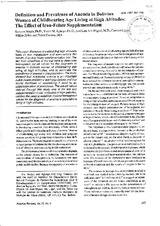Mostrar el registro sencillo del ítem
Definition and prevalence of anemia in Bolivian women of childbearing age living at high altitudes : the effect of iron-folate supplementation
| dc.contributor.author | Berger, Jacques | |
| dc.contributor.author | Aguayo, Víctor M | |
| dc.contributor.author | San Miguel, José Luis | |
| dc.contributor.author | Lujan, Carmen | |
| dc.contributor.author | Tellez, Wilma | |
| dc.contributor.author | Traissac, Pierre | |
| dc.date.accessioned | 2019-07-17T13:31:47Z | |
| dc.date.available | 2019-07-17T13:31:47Z | |
| dc.date.issued | 1997 | |
| dc.identifier.uri | http://repositorio.umsa.bo/xmlui/handle/123456789/21913 | |
| dc.description.abstract | Abstract. This paper discusses the effect that high altitudes have on iron metabolism and summarizes the results of an iron-folate supplementation trial. The two main objectives of the trial were to determine hemoglobin cut-off values for the diagnosis of anemia in Bolivian women of childbearing age living at high altitudes, and to estimate the prevalence of anemia in this population. The study showed that nutritional anemia is an important public health problem in such populations and that many methods of assessing it lead to an underestimation of prevalence. The cut-off values defined through this study, one of the few iron supplementation trials conducted at high altitudes, confirm the need to establish revised hemoglobin values for the diagnosis of anemia in populations living at high altitudes. | es_ES |
| dc.language.iso | en | es_ES |
| dc.publisher | Nutrition Reviews | es_ES |
| dc.subject | ANEMIA | es_ES |
| dc.subject | BOLIVIA | es_ES |
| dc.subject | MUJERES EDAD FÉRTIL | es_ES |
| dc.subject | ALTURA | es_ES |
| dc.subject | SUPLEMENTACIÓN CON HIERRO-FOLATO | es_ES |
| dc.title | Definition and prevalence of anemia in Bolivian women of childbearing age living at high altitudes : the effect of iron-folate supplementation | es_ES |
| dc.type | Article | es_ES |

